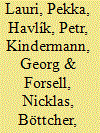|
|
|
Sort Order |
|
|
|
Items / Page
|
|
|
|
|
|
|
| Srl | Item |
| 1 |
ID:
109599


|
|
|
|
|
| Publication |
2011.
|
| Summary/Abstract |
Recently, an active debate has emerged around greenhouse gas emissions due to indirect land use change (iLUC) of expanding agricultural areas dedicated to biofuel production. In this paper we provide a detailed analysis of the iLUC effect, and further address the issues of deforestation, irrigation water use, and crop price increases due to expanding biofuel acreage. We use GLOBIOM - an economic partial equilibrium model of the global forest, agriculture, and biomass sectors with a bottom-up representation of agricultural and forestry management practices. The results indicate that second generation biofuel production fed by wood from sustainably managed existing forests would lead to a negative iLUC factor, meaning that overall emissions are 27% lower compared to the "No biofuel" scenario by 2030. The iLUC factor of first generation biofuels global expansion is generally positive, requiring some 25 years to be paid back by the GHG savings from the substitution of biofuels for conventional fuels. Second generation biofuels perform better also with respect to the other investigated criteria; on the condition that they are not sourced from dedicated plantations directly competing for agricultural land. If so, then efficient first generation systems are preferable. Since no clear technology champion for all situations exists, we would recommend targeting policy instruments directly at the positive and negative effects of biofuel production rather than at the production itself.
|
|
|
|
|
|
|
|
|
|
|
|
|
|
|
|
| 2 |
ID:
127867


|
|
|
|
|
| Publication |
2014.
|
| Summary/Abstract |
From a biophysical perspective, woody biomass resources are large enough to cover a substantial share of the world's primary energy consumption in 2050. However, these resources have alternative uses and their accessibility is limited, which tends to decrease their competitiveness with respect to other forms of energy. Hence, the key question of woody biomass use for energy is not the amount of resources, but rather their price. In this study we consider the question from the perspective of energy wood supply curves, which display the available amount of woody biomass for large-scale energy production at various hypothetical energy wood prices. These curves are estimated by the Global Biosphere Management Model (GLOBIOM), which is a global partial equilibrium model of forest and agricultural sectors. The global energy wood supply is estimated to be 0-23 Gm3/year (0-165 EJ/year) when energy wood prices vary in a range of 0-30$/GJ (0-216$/m3). If we add household fuelwood to energy wood, then woody biomass could satisfy 2-18% of world primary energy consumption in 2050. If primary forests are excluded from wood supply then the potential decreases up to 25%.
|
|
|
|
|
|
|
|
|
|
|
|
|
|
|
|
|
|
|
|
|